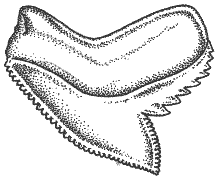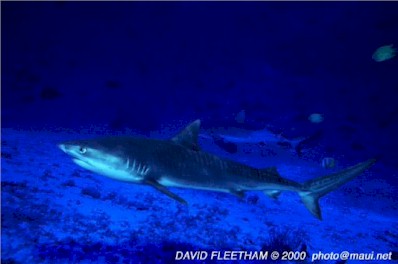Tooth of the Tiger
Responding to a comment that the Tiger Shark specifically hunted/favored sea turtles and was a specialized predator with specialized dentition, I wrote:
While it is true that the Tiger Shark (Galeocerdo cuvier) apparently includes sea turtles in its diet with greater frequency than any other shark, it is at best a gross oversimplification and at worst highly misleading to state that this species specializes in chelonian prey.
 Numerous dietary analyses (eg: Rancurel & Intes 1982, Simpendorfer 1992,
Lowe et al. 1996, etc.) indicate that, at all predator size classes, fishes —
especially teleosts — are the predominant prey type of Tiger Sharks. Taxonomic
diversity and maximum dimension of prey in this species increase with length, so
that larger Tiger Sharks take a relatively greater proportion of marine
reptiles, birds, and mammals than do smaller individuals of the same
species.
Numerous dietary analyses (eg: Rancurel & Intes 1982, Simpendorfer 1992,
Lowe et al. 1996, etc.) indicate that, at all predator size classes, fishes —
especially teleosts — are the predominant prey type of Tiger Sharks. Taxonomic
diversity and maximum dimension of prey in this species increase with length, so
that larger Tiger Sharks take a relatively greater proportion of marine
reptiles, birds, and mammals than do smaller individuals of the same
species.
Thus, Tiger Sharks do not specialize in such prey, any more than large White Sharks (Carcharodon carcharias) specialize in, or undertake a whole-sale dietrary shift to, marine mammal prey. As with large White Sharks taking marine mammal prey, Tiger Sharks take sea turtles simply because they can; smaller Tiger Sharks lack the sheer bulk (and probably bite strength and predatory skill) to overpower such large, strong-swimming and tough-shelled prey. As stated repeatedly during the advertisement campaign for the 1998 Devlin-Emmerich film, Godzilla: "Size does matter".
 Similarly, it has long and widely been stated uncritically that the Tiger
Shark's characteristic tooth shape (each featuring a deep primary notch, with
large serial cusplets along the distal edge of the serrated blade) is 'specialized'
for feeding on sea turtles. While it is true that such 'tin opener' dentition is
ideally suited to puncturing and tearing open hard-shelled prey such as sea
turtles, this tooth structure was not evolved 'in order to' feed on chelonians.
The processes of evolution do not operate in anticipation of potential future
use. The tooth shape of the Tiger Shark is merely an expression (albeit a
functionally and esthetically beautiful one) of squamous developmental plasticity
constrained by ancestry. (Indeed, the 'unique' cockscomb-shaped teeth of the
Tiger Shark seem to be a relatively minor modification of the basic dental
morphology inherited from the hemigaleids, the apparent primitive sister group
of the carcharhinids; phylogenetically, this basic tooth morphology can be
traced back at least as far as the so-called 'intermediate carcharhinoids', such
as the triakids and galeorhinids — but I'd best exercise some caution and
humility here, as I have only recently begun exploring shark paleontology in
earnest! ; > ) My point is that the dentition of the Tiger Shark is not specialized
to feed on sea turtles; rather, the dentition that the Tiger Shark happens to
have evolved allows it to take tough-shelled prey such as sea turtles.
This is a subtle but important distinction.
Similarly, it has long and widely been stated uncritically that the Tiger
Shark's characteristic tooth shape (each featuring a deep primary notch, with
large serial cusplets along the distal edge of the serrated blade) is 'specialized'
for feeding on sea turtles. While it is true that such 'tin opener' dentition is
ideally suited to puncturing and tearing open hard-shelled prey such as sea
turtles, this tooth structure was not evolved 'in order to' feed on chelonians.
The processes of evolution do not operate in anticipation of potential future
use. The tooth shape of the Tiger Shark is merely an expression (albeit a
functionally and esthetically beautiful one) of squamous developmental plasticity
constrained by ancestry. (Indeed, the 'unique' cockscomb-shaped teeth of the
Tiger Shark seem to be a relatively minor modification of the basic dental
morphology inherited from the hemigaleids, the apparent primitive sister group
of the carcharhinids; phylogenetically, this basic tooth morphology can be
traced back at least as far as the so-called 'intermediate carcharhinoids', such
as the triakids and galeorhinids — but I'd best exercise some caution and
humility here, as I have only recently begun exploring shark paleontology in
earnest! ; > ) My point is that the dentition of the Tiger Shark is not specialized
to feed on sea turtles; rather, the dentition that the Tiger Shark happens to
have evolved allows it to take tough-shelled prey such as sea turtles.
This is a subtle but important distinction.
The slenderness and overall proportions of this Tiger Shark (Galeocerdo cuvier) indicate that it is a relatively small individual, not yet sexually mature. Note the faint tiger-like markings on its flanks and upper caudal lobe that give this species its common name.
Photo © David Fleetham david@davidfleetham.com; used with the gracious permission of the photographer.
Although it occasionally makes forays into cool temperate and even boreal seas, the Tiger Shark is primarily an inhabitant of warm waters. Such tropical and subtropical marine habitats are relatively nutrient poor compared with the cool temperate waters apparently favored by the White Shark. To survive in such an environment, the Tiger Shark has had to become a highly opportunistic predator-scavenger, a kind of Hyena of the Sea. Like other sharks, the Tiger Shark takes whatever prey is both locally abundant and amenable to capture/processing by whatever feeding structures it happens to possess.
That the Tiger Shark is able to extend its basically piscivorous diet to take such large, powerful, and tough-shelled prey as sea turtles is testimonial to the adaptability and predatory plasticity of its inherited morphology. But it is a fundamental mistake to assume that simply because a creature can do something that it has been adapted to do it.
Cheers,
— R. Aidan Martin
[Posted to SHARK-L May 5, 1999]

